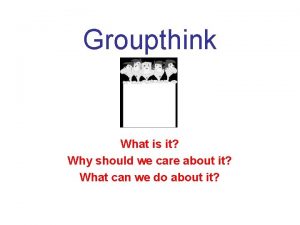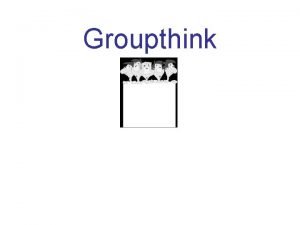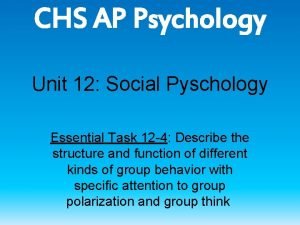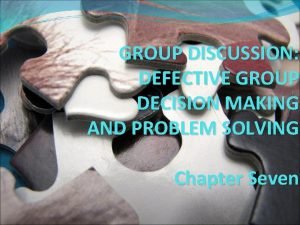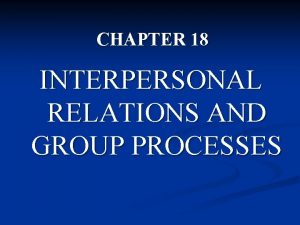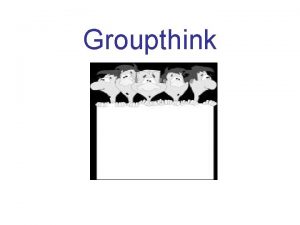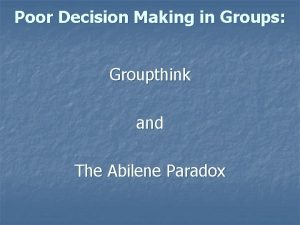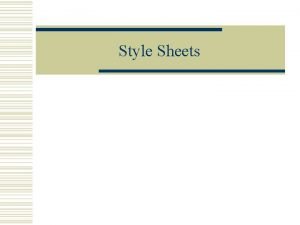Groupthink Groups sometimes fall into a style of












- Slides: 12

Groupthink Groups sometimes fall into a style of thinking where the maintenance of the group’s cohesion and togetherness becomes all-important and results in very bad decision-making.

Groupthink is a type of thought exhibited by group members who try to minimize conflict and reach consensus without critically testing, analyzing, and evaluating ideas Individual creativity, uniqueness, and independent thinking are lost in the pursuit of group cohesiveness, as are the advantages of reasonable balance in choice and thought that might normally be obtained by making decisions as a group.

What is Groupthink? Janis (1972) defines it as "a way of deliberating that group members use when their desire for unanimity overrides their motivation to assess all available plans of action. "

Symptoms of Groupthink Illusions of invulnerability where the group think it is invincible and can do no wrong. Collective efforts to rationalize or discount warnings. Unquestioned belief in the moral correctness of the group. Stereotyped views of the out-group, often as too evil, weak or stupid to be worth bothering with.

Symptoms of Groupthink Self-censorship as people decide not to rock the boat. Pressure to conform. A shared illusion of unanimity (everyone always agrees with everyone else). Protecting the group from contrary viewpoints, by self-appointed ‘mindguards’.

When does it happen? Groupthink happens most often when the group is already cohesive, is isolated from conflicting opinions and where the leader is open and directive. The lack of a formal decision process is also common. Problem-solving and task-oriented groups are particularly susceptible. Resulting decisions are often based on incomplete information and fail to consider alternatives and risks.

Conflict Causes: Uncertainty over people’s roles Not enough resources available Having to rely on others to complete a task Competing objectives / views Organization structures that cause differences among staff Unresolved prior conflicts

Conflict Resolution Eliminates underlying causes of conflict and reduces potential for similar conflict to re-occurring ◦ Appeal to a higher goal that everyone can agree on ◦ Make more resources available ◦ Changing people – transfers ◦ Altering physical environment

Conflict Resolution ◦ Changing reward system ◦ Changing policy or procedures ◦ Training in interpersonal skills ◦ Integrating the organization with special teams or liaison personal

Conflict Management Styles Avoidance: being uncooperative and unassertive, downplaying disagreement, staying neutral at all costs. (lose-lose conflict) Accommodation: being cooperative but unassertive, overlooking differences to maintain harmony (lose conflict)

Conflict Management Styles Competition: being uncooperative and assertive, working against the wishes of other party members (win-lose comflict) Compromise: being moderately cooperative and assertive, bargaining for acceptable solution (win-lose conflict)

Conflict Management Styles Collaboration: problem solving, cooperative and assertive, trying to satisfy everyone’s needs (win-win conflict)
 Sometimes you win some
Sometimes you win some God when you choose to leave mountains unmovable
God when you choose to leave mountains unmovable Sometimes sweet sometimes sour
Sometimes sweet sometimes sour Sometimes cold sometimes hot
Sometimes cold sometimes hot Self appointed mindguards
Self appointed mindguards Group polarization vs groupthink
Group polarization vs groupthink Groupthink occurs in
Groupthink occurs in Module 74 ap psychology
Module 74 ap psychology Deindividuation ap psychology
Deindividuation ap psychology Defective decision making
Defective decision making Group think vs group polarization
Group think vs group polarization Groupthink vs group polarization
Groupthink vs group polarization Groupthink adalah
Groupthink adalah




